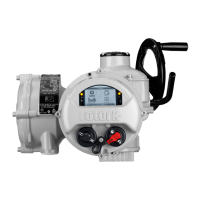6 IQ3 manual – Section: Health and Safety
The electrical installation, maintenance
and the use of the actuator should be
carried out in accordance with the code
of practice relevant for that particular
Hazardous Area certification.
No inspection or repair should be
undertaken unless it conforms to the
specific hazardous area certification
requirements. Under no circumstances
should any modification or alteration
be carried out on the actuator as this
could invalidate the actuators hazardous
area approval certification. Access to live
electrical conductors is forbidden in the
hazardous area unless this is done under
a special permit to work, otherwise
all power should be isolated and the
actuator moved to a non-hazardous area
for repair or attention.
WARNING: Service Altitude
The actuator installation altitude must
be restricted to less than 2000 m
as defined by IEC61010-1 (Safety
requirements for electrical equipment
for measurement, control and
laboratory use).
WARNING: Motor Temperature
Under normal operation the
temperature of actuator’s motor cover
surfaces can exceed 60 °C above
ambient.
WARNING: Surface Temperature
The installer/user must ensure that the
actuator surface temperature rating
is not influenced by external heating/
cooling effect (e.g. valve/pipeline
process temperatures).
WARNING: Thermostat Bypass
If the actuator is configured to
bypass the motor thermostat then
the hazardous area certification will
be invalidated. Additional electrical
hazards may occur when using this
configuration. The user should ensure
that any necessary additional safety
measures are considered.
WARNING: Enclosure Materials
IQ Range of actuators are
manufactured from aluminium alloy
with stainless steel fasteners and the
thrust bases are manufactured in cast
iron.
The cover window is toughened glass
which is retained with a 2-part silicone
cement and the battery plug will be
either stainless steel or PPS (Poly-
Phenolyne Sulfide).
The user must ensure that the
operating environment and any
materials surrounding the actuator
cannot lead to a reduction in the safe
use of, or the protection afforded
by, the actuator. Where appropriate
the user must ensure the actuator is
suitably protected against its operating
environment.
WARNING: Operating by Hand
With respect to handwheel operation
of Rotork electric actuators, refer to
section 4.1.
WARNING: Actuator may start
and operate when remote is
selected. This will be dependent on
remote control signal status and
actuator configuration.

